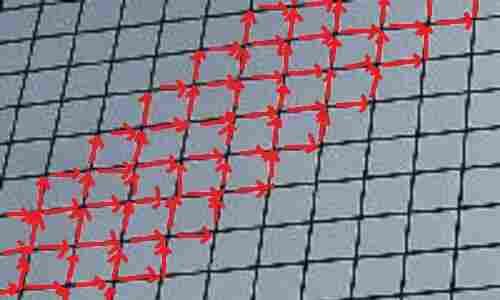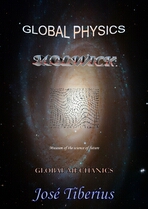2.c.2. LUM Aether (Luminiferous, universal, and mobile) and properties of photons
In describing the stages of electromagnetic waves, we indirectly pointed out some of the properties of light waves, or photons, according to the interpretation of Quantum Mechanics and Relativity that Global Physics supposes. Likewise, we mentioned the dual nature of light or the wave-particle duality of electromagnetic waves in the sense of being transverse mechanical waves on LUM Aether (Luminiferous, universal, and mobile) –longitudinal tension of the reticular structure of matter or Global Aether.
An important characteristic or property of the wavelike behavior of light, which we study in the book Law of Global Gravity, is the movement of light regarding the curvature of light, or the natural phenomenon of gravitational lenses, as explained by the Merlin Effect.
Now we will look at other interesting properties of light waves, or photons, which are critical aspects of the current theories of Modern Physics, and that would change with the Global Mechanics. We will look specifically at topics regarding the postulate of the constancy of the speed of light, the mass of photons and the previously mentioned dual behavior of light, or its wave-particle duality.
The new definition of a photon implies the following properties of electromagnetic waves:
Propagation of magnetic waves and constant speed of light
One consequence of the definition of gravity and the wavelike behavior of the photon, as a transverse wave on the tension of the longitudinal curvature of Global Aether, is gravity as the supporting medium for the propagation of light waves or LUM Aether (Luminiferous, universal, and mobile). The Global Physics proposes this interpretation of the Michelson-Morley experiment; especially as regards the entrainment of electromagnetic energy in line with the Lense-Thirring effect.
If the propagation of transverse waves has a variable speed depending on its intensity or frequency in a mechanical medium, we call this a dispersive medium, and the contrary would be a non-dispersive medium. By this definition, LUM Aether (Luminiferous, universal, and mobile) would be a non-dispersive medium.
Another property of light waves of equal or greater importance is that their speed of propagation in a non-dispersive medium, such as gravity field, it does not depend on the electromagnetic energy or frequency but the parameters of the longitudinal elasticity or rigidity of the filaments of Global Aether –supporting medium of the LUM Aether (Luminiferous, universal, and mobile), and indirectly, of light.
Intuitively speaking, one can better grasp the concept of the constant speed of light by imagining that if one were to strike a train rail twice, the sound would not travel faster than if one were to strike it only once. In other words, the speed of light does not depend on the energy or frequency of the waves. (This is a useful example assuming that said rails constitute a non-dispersive medium).
On the other hand, Maxwell proposed a formula for the speed of propagation of light waves, based on the magnetic permeability of vacuum µ0 and the permittivity of vacuum (dielectric constant) ε0. This famous formula reminds us a lot of the speed of propagation of transverse waves in strings, which depends on the square root of the tension of the string divided by the linear density of the string.
c² = 1/ µ0 ε0
c = ( µ0 ε0)-1/2It seems as though Maxwell thought of LUM Aether (Luminiferous, universal, and mobile) as the mechanical medium of light waves, or photons. Another ironic fact in the history of science, since nowadays; Maxwell’s prediction serves as an indisputable argument sustaining the Theory of Relativity. It is as if the winners of scientific battles also wrote the history of knowledge.
Propagation of magnetic waves and the variable speed of light
From a dogmatic approach, according to the formula proposed by Maxwell on the velocity of propagation of light waves or photons, the most important fact is that the speed of propagation of a mechanical wave in a non-dispersive medium is a property of light waves, which relates to the square root of tension and density. This property suggests the inaccuracy of a large part of the Theory of Relativity by implying a variable speed of light due to the longitudinal tension changing the intensity of the gravitational field –LUM Aether (Luminiferous, universal, and mobile).
Furthermore, if the gravitational field is a supporting medium for electromagnetic energy, if we measure the velocity of propagation of photons in a system of reference external to the gravitational field, it will be greater when the gravitational field moves in the same direction, and lower in the opposite case.
Mass and non-mass of photons
The property of photons, of being mechanical waves along the LUM Aether directly indicates that light and photons do not have mass.
Nevertheless, due to the proper mechanism of origin, transmission, and collapse of the transverse magnetic waves that we have described, it could be said that, from a strict point of view, a spatial variation in the material (or physical) reality exists due to the property of elasticity of Global Aether.
A photon does not have mass and is not a particle (in the material sense of the word) but, as a dynamic property of Global Aether, its energy brings about a succession of small movements in different elastocytes during the propagation of a light wave.
In other words, photons change the density of the Global Aether and, when a particle with mass absorbs a photon, the mass increases its density.
Perhaps the concept of a photon as a particle without mass and being able to transmit a linear momentum was a paradox, but once explained it ceases to be so. It is neither a paradox nor a particle in the non-technical concept. In our opinion, science consists of explaining paradoxes, not relying on them –let alone reveling in them. Therefore, it is better to talk of light or photons as a dynamic property of the elasticity of Global Aether due to being a transverse mechanical wave than as a particle without mass.
On the other hand, the book Law of Global Gravity, when talking about the atractis causa of the gravitational force, explains that gravity affects electromagnetic energy due to the same mechanism as mass, and what is more, it affects twice as much due to the speed of propagation of electromagnetic energy. In other words, electromagnetic energy is an energetic property of Global Aether just as mass is, but this does not mean that photons and mass are identical from all perspectives.
The wave-particle duality of light
In the previous point, we have just explained how Global Mechanics understands the wave-particle duality of light and the topics regarding the double-slit experiment and the photoelectric effect. It is worth repeating that a wave created by torsion advancing through a single filament should not produce diffraction nor pass through two slits. However, the filaments make up part of the Global Aether, and a photon affects a collection of them.
When the electron disappears due to the change in orbital level, it will affect many filaments of Global Aether until it reappears in another level.
LUM Aether Photon propagation 
Likewise, the results of all the forces will spread the impulse through the elastocytes up to certain extent, in the direction of movement for each reticule of the Global Aether. This characteristic or property of light waves and photons would explain the wavelike behavior of light in the Young experiment or the double-slit experiment.
A different problem from that of the wave-particle duality of light, or photons, is the double-slit experiment with electrons –but we will try to explain this topic when describing what electrons are and how they move.
An encouraging example is to see in Wikipedia how Quantum Theory resolves the paradox of the Young experiment or double-slit experiment when emitting photons one by one. They propose that the probability functions of finding a particle at a specific point interfere with each other. Never mind that the functions represent waves of which they are not aware, but only in the world of Quantum Theory would it be possible for a mathematical function to have a real effect. Pardon us; this also occurs in the world of the Theory of Relativity, along with the concept of gravity as a geometric effect in space-time.
We say that this is encouraging for two reasons, because Quantum Mechanics has a mathematical mechanism impressively adapted to the properties of photons in the physical reality. Therefore, it must be possible to calculate with great accuracy the size of a reticule, the elastocytes and other ideas derived.
The second reason is that the logical justification is often glaringly absent, thereby leaving a clear gap for physical theories such as Global Mechanics.
